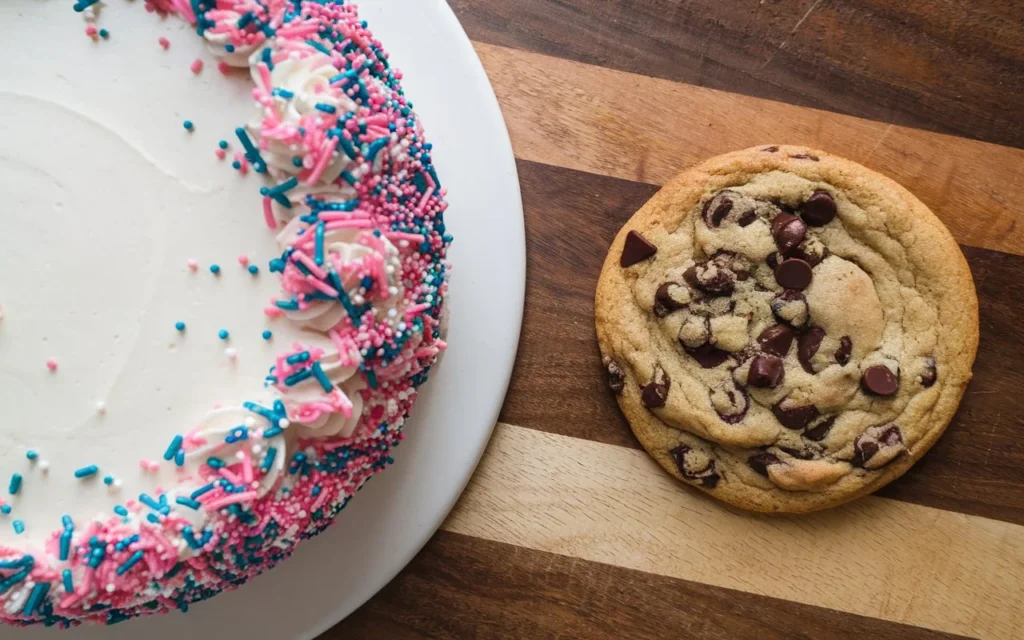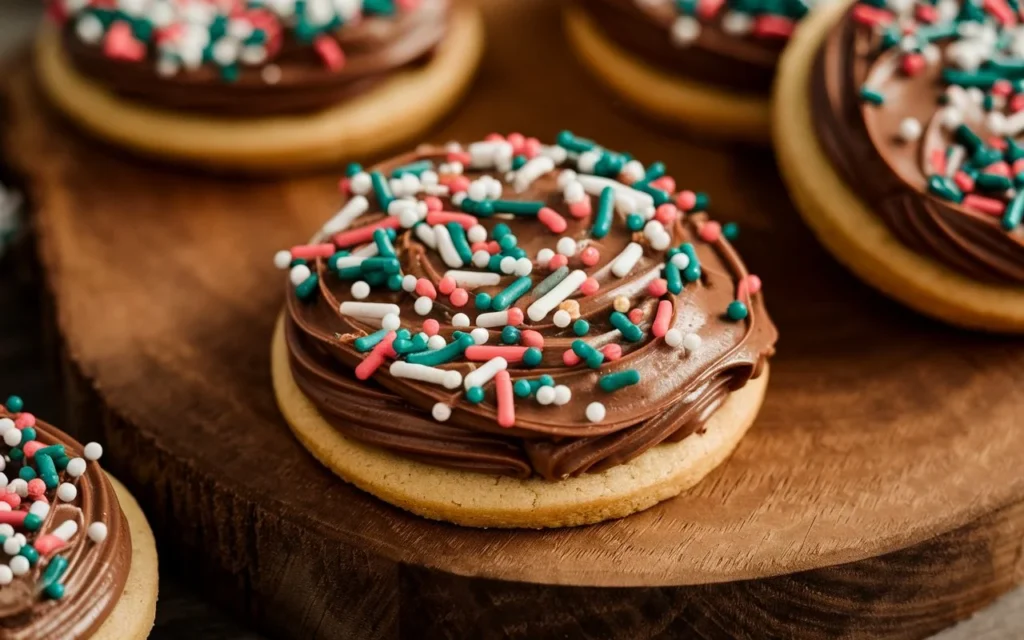Introduction
Ever craved the softness of cake but wanted the ease of a cookie? Well, cake cookies are here to satisfy both cravings at once! These delightful treats bring together the fluffiness of a cake and the chewy, handheld charm of a cookie. Whether you want a quick dessert hack using cake mix or prefer to bake them from scratch, this article has got you covered.
From simple recipes like chocolate cake cookies to vibrant options like red velvet and lemon, there’s something for every sweet tooth. But that’s not all! You’ll also learn essential baking tips, flavor-boosting techniques, and answers to all your burning questions about baking the perfect cake cookie.
Without further ado, let’s get to Part 1, where we unravel the basics of cake cookies, their appeal, and how they stand apart from regular cookies.
Introduction to Cake Cookies
What Are Cake Cookies?
Cake cookies are a delightful cross between the soft, fluffy texture of cake and the crisp edges of a cookie. Unlike traditional cookies, which are usually dense and chewy, cake cookies have a light, tender interior that feels like biting into a miniature slice of cake. This unique texture is achieved by altering the ratio of key ingredients like fat, flour, and sugar, or by using pre-made cake mix as a shortcut.
What makes them so special, you ask? Well, it’s the balance of soft and firm textures in every bite. The edges have just the right amount of crispness, while the center stays soft, light, and full of flavor. Plus, they’re incredibly versatile! By using different cake mix flavors like chocolate, vanilla, lemon, or red velvet, you can make a wide variety of cake cookies without having to master advanced baking techniques.
Why Are Cake Cookies So Popular?
There’s no doubt that cake cookies have become a favorite in homes, bakeries, and even at holiday parties. But why are they so popular? Here are a few reasons why these treats are winning hearts:
- Ease of Preparation: Unlike traditional cookies, cake cookies can be made with as little as three ingredients – cake mix, eggs, and oil. It’s a time-saver, especially when you’re in a rush but still want to bake something special.
- Soft, Fluffy Texture: Regular cookies are chewy, but cake cookies have that light, cloud-like texture that you only get from cakes. It’s the best of both worlds.
- Flavor Variety: From chocolate to lemon to red velvet, you can make cake cookies in almost any flavor imaginable. You can even customize them with add-ins like chocolate chips, sprinkles, or candy pieces.
- Perfect for Occasions: Whether it’s a birthday party, baby shower, or holiday gathering, cake cookies are always a hit. They look pretty, taste amazing, and don’t require hours of kitchen labor.
Cake Cookies vs. Regular Cookies
If you’re wondering how cake cookies stack up against regular cookies, here’s a quick breakdown:
| Feature | Cake Cookies | Regular Cookies |
|---|---|---|
| Texture | Soft, fluffy, cake-like | Dense, chewy, or crispy |
| Ingredients | Often made with cake mix | Uses traditional cookie dough |
| Baking Time | Slightly shorter (less spread) | Longer for chewy centers |
| Customization | Endless flavor combos | Limited to standard cookie flavors |
| Ease of Use | 3 ingredients possible | Requires butter, sugar, flour |
As you can see, cake cookies are in a league of their own. Their texture, simplicity, and customization options make them a favorite for both beginner bakers and dessert pros alike.
How Are Cake Cookies Made?
The process for making cake cookies is refreshingly simple. You can choose between two methods – using cake mix or making them from scratch. Here’s a brief look at each option:
- Using Cake Mix:
This is the easiest way to make cake cookies. You only need 3 ingredients:- 1 box of cake mix (chocolate, vanilla, red velvet, etc.)
- 2 eggs
- 1/3 cup of oil (vegetable or canola oil works best)
- Mix the cake mix, eggs, and oil together in a large bowl.
- Scoop tablespoon-sized balls of dough onto a lined baking sheet.
- Bake at 350°F (175°C) for 10-12 minutes.
- Let them cool for 5 minutes before transferring to a wire rack.
- From Scratch Method:
If you prefer to avoid store-bought cake mix, you can make cake cookies from scratch using a custom blend of flour, sugar, leavening agents, and flavorings. Here’s an overview of the process:- Cream butter and sugar together.
- Beat in eggs, vanilla, and other flavorings.
- Add dry ingredients (flour, baking powder, and salt) slowly to form the dough.
- Scoop and bake as you would with the cake mix method.
Both methods result in soft, flavorful cookies that melt in your mouth. If you’re in a hurry, the cake mix method is unbeatable. But if you’re in the mood for something more “homemade,” the from-scratch option is worth a try.
Why You Should Try Making Cake Cookies
If you haven’t tried making cake cookies yet, you’re seriously missing out. These cookies are:
- Time-Saving: Make them in under 30 minutes!
- Customizable: Switch up flavors, colors, and toppings.
- Perfect for Beginners: No special skills required.
- Kid-Friendly: Children can help mix, roll, and decorate.
With all these perks, it’s easy to see why cake cookies have become a popular choice for holiday treats, bake sales, and weekend baking sessions.

The Science Behind Cake Cookies
When it comes to baking cake cookies, science plays a bigger role than you might think. Every ingredient you add — from flour to sugar — has a specific job. Understanding how these elements interact is key to creating cookies that are soft, fluffy, and downright irresistible. Let’s take a closer look at the role of each essential ingredient and the science behind that perfect cake cookie texture.
Key Ingredients in Cake
Flour
Flour is the backbone of any baked good, and cake cookies are no exception. The type of flour used can significantly impact the final texture. Most cake cookies rely on all-purpose flour, which gives the cookies structure and helps them hold their shape. However, some bakers use cake flour to achieve an even softer, more delicate crumb. Cake flour has a lower protein content, which means less gluten development, resulting in a finer, fluffier texture — exactly what you want in a cake cookie.
Leavening Agents
Leavening agents like baking powder and baking soda are responsible for the rise in cake cookies. While traditional cookies often stay flat, cake cookies puff up as they bake, creating a soft, airy texture. Baking powder, which contains both an acid and a base, reacts with moisture and heat to create gas bubbles that expand the dough. This is why cake cookies often have that iconic crackled surface.
Fats
Fats, such as butter, margarine, or oil, impact flavor, texture, and moisture. Butter adds a rich, creamy flavor, but oil often produces softer, longer-lasting cake cookies. Why? Oil is 100% fat, while butter contains water. The absence of water in oil prevents gluten from forming too much, keeping the cookies tender and soft. Additionally, because oil remains in a liquid state at room temperature, cookies made with oil stay softer for longer.
Sugar
Sugar does more than sweeten your cake cookies — it also affects texture, color, and spread. White sugar creates crisp edges, while brown sugar adds moisture and chewiness due to its molasses content. In cake cookies, a mix of both sugars may be used to achieve a balance between softness and slight crispness. If you want a softer cake cookie, use more brown sugar or substitute white sugar with powdered sugar.
Eggs
Eggs act as a binder, holding everything together. They add moisture, promote rise, and improve the overall structure of the cookies. The protein in eggs strengthens the dough, while the yolks provide richness and tenderness. It’s no surprise that most cake cookie recipes call for at least one or two eggs, as they’re essential for that classic cake-like texture.
How Texture and Flavor Are Achieved
The secret to the soft, fluffy texture of cake cookies is all about balance. When the right ratio of moisture, fat, and leavening agents is achieved, the cookies rise, set, and maintain their signature soft center. Too much moisture, and you’ll end up with sticky, doughy cookies. Too little, and you’ll get dry, crumbly results.
Here’s how the science works:
- Moisture: This comes from eggs, oil, and any other liquid ingredients in the dough. More moisture = softer cookies.
- Fats: Butter, margarine, or oil contribute richness, but oil produces softer cookies that stay fresh for longer.
- Leavening: Leavening agents like baking powder create gas bubbles that give the cookies height, making them light and airy.
Together, these elements produce that tender, fluffy crumb that makes cake cookies so addictive.
Differences Between Cake Cookies and Traditional Cookies
It’s easy to confuse cake cookies with regular cookies, but their differences are clear when you look at texture, preparation, and taste.
| Category | Cake Cookies | Traditional Cookies |
|---|---|---|
| Texture | Soft, fluffy, cake-like | Dense, chewy, or crispy |
| Ingredients | Often made with cake mix | Uses traditional cookie dough |
| Leavening | Higher leavening, more rise | Lower leavening, stays flat |
| Baking Time | Shorter baking time | Slightly longer for even baking |
| Customization | Unlimited flavors and mix-ins | Limited to common cookie flavors |
Traditional cookies are known for their chewiness or crisp edges, while cake cookies are soft and pillowy. Since cake mixes are often used as the base for cake cookies, they come with pre-measured ingredients, which makes preparation faster and more consistent. This ease of preparation is a big reason why so many people love baking cake cookies.
Popular Cake Cookie Recipes

When it comes to cake cookies, the recipe possibilities are endless. From chocolate lovers to fruity flavor enthusiasts, there’s a recipe for everyone. Here are six delicious cake cookie recipes that are easy to make and impossible to resist.
Classic Chocolate Cake
Rich, chocolatey, and oh-so-decadent, chocolate cake cookies are a must-try for chocolate lovers.
Ingredients
- 1 box of chocolate cake mix
- 2 large eggs
- 1/3 cup vegetable oil
- Optional: Chocolate chips for extra indulgence
Steps
- Preheat the oven to 350°F (175°C).
- Mix the cake mix, eggs, and oil in a bowl until a dough forms.
- Fold in chocolate chips if using.
- Scoop dough onto a lined baking sheet and bake for 10-12 minutes.
Red Velvet Cake
These vibrant red cookies are festive and delicious, perfect for holidays or Valentine’s Day.
Ingredients
- 1 box of red velvet cake mix
- 2 large eggs
- 1/3 cup oil
- Optional: White chocolate chips or cream cheese frosting
Steps
- Preheat the oven to 350°F (175°C).
- Combine the cake mix, eggs, and oil to form a dough.
- Roll dough into balls, bake for 10-12 minutes, and cool before adding frosting.
Lemon Cake Cookies
Refreshing, zesty, and perfect for spring or summer, lemon cake cookies add a citrusy twist to dessert time.
Ingredients
- 1 box of lemon cake mix
- 2 large eggs
- 1/3 cup oil
- Powdered sugar for dusting
Steps
- Preheat oven to 350°F (175°C).
- Roll dough balls in powdered sugar before baking for a crinkle effect.
- Bake for 10-12 minutes, then cool and dust with more powdered sugar.
Strawberry Cake Cookies
Pretty in pink, these fruity, colorful cookies are perfect for parties and kids’ events.
Ingredients
- 1 box of strawberry cake mix
- 2 large eggs
- 1/3 cup oil
- Optional: White chocolate chips
Steps
- Preheat oven to 350°F (175°C).
- Mix the cake mix, eggs, and oil.
- Fold in white chocolate chips.
- Bake for 10-12 minutes, then cool before serving.
Funfetti Cake Cookies
Bright, colorful, and full of rainbow sprinkles, these cookies scream “celebration”!
Ingredients
- 1 box of funfetti cake mix
- 2 large eggs
- 1/3 cup oil
- Extra sprinkles for decoration
Steps
- Mix the cake mix, eggs, and oil.
- Fold in extra sprinkles for an explosion of color.
- Bake for 10-12 minutes and let them cool before serving.
Cookies & Cream Cake
Who doesn’t love Oreos? These cookies bring that iconic flavor to every bite.
Ingredients
- 1 box of white cake mix
- 2 large eggs
- 1/3 cup oil
- Crushed Oreos
Steps
- Mix crushed Oreos into the cookie dough for bursts of flavor.
- Bake at 350°F for 10-12 minutes.
- Cool before devouring!
Tips for Perfect Cake
Baking cake cookies isn’t complicated, but a few simple tips can make the difference between dry, crumbly cookies and soft, fluffy perfection. From baking techniques to storage hacks, here’s how to get it right every time.
How to Avoid Dry Cake Cookies
Don’t Overbake
Take cookies out as soon as the edges are firm but the center looks slightly undercooked. They’ll finish baking as they cool.
Use Oil Instead of Butter
Oil keeps cookies softer for longer since it’s 100% fat, unlike butter, which contains water.
Avoid Over-Mixing
Mix the dough just until ingredients combine. Over-mixing activates gluten, making cookies tough.
Ways to Customize cake
Flavor Variations
Try pumpkin spice for fall, lemon for spring, or peppermint for the holidays. Seasonal flavors keep your cake cookies fresh and exciting.
Mix-Ins & Add-Ins
Add chocolate chips, M&Ms, crushed Oreos, or dried fruits for flavor and texture.
Frostings & Glazes
Drizzle powdered sugar glaze, cream cheese frosting, or melted chocolate on top for added flavor and a professional finish.
How to Store Cake Cookies
Room Temperature: Store in an airtight container for up to 7 days. Add a slice of bread to keep cookies soft.
Refrigeration: Store in the fridge for up to 2 weeks in an airtight container.
Freezing: Freeze baked cookies or raw dough for up to 3 months. Bake frozen dough balls directly with 2-3 extra minutes of cook time.
Common Mistakes to Avoid
Overbaking: Cookies keep baking as they cool. Pull them out as soon as the edges set.
Skipping Chill Time: Chilling the dough keeps cookies from spreading too much.
Using Melted Butter: Melted butter makes dough too loose. Use softened butter or oil instead.
FAQs
What makes cake cookies different from regular cookies?
Cake cookies have a soft, fluffy texture like cake, while regular cookies are denser and chewier.
Can I make cake cookies without cake mix?
Yes, by using flour, sugar, and leavening agents to achieve the right texture.
Can I use any type of cake mix?
Absolutely! Chocolate, vanilla, lemon, Funfetti — any cake mix works.
Why are my cake cookies dry?
Overbaking or using too much flour can make them dry. Use oil for extra moisture.
How do I keep my cake cookies soft?
Store them with a slice of bread in an airtight container. Avoid overbaking and use oil instead of butter.
Can I freeze cake cookies?
Yes! Freeze baked cookies or raw dough for up to 3 months.
Conclusion
Cake cookies offer the best of both worlds — the softness of cake and the simplicity of cookies. By following these tips, you’ll bake moist, tender cookies every time. Customize them with your favorite flavors, mix-ins, and toppings for a unique treat that’s sure to impress. Whether you’re baking for a party, a holiday, or just for fun, cake cookies are the perfect dessert for any occasion.


